
Cornus florida, the flowering dogwood, is a species of flowering tree in the family Cornaceae native to eastern North America and northern Mexico. An endemic population once spanned from southernmost coastal Maine south to northern Florida and west to the Mississippi River. The tree is commonly planted as an ornamental in residential and public areas because of its showy bracts and interesting bark structure.

The nutmeg, also known as the clover cutworm, is a moth of the family Noctuidae.

Hypena is a genus of moths in the family Erebidae. It was first described by Franz von Paula Schrank in 1802. These non-migratory moths overwinter as pupae and almost never estivate as adults.

Nigetia is a monotypic moth genus in the family Erebidae. Its only species, Nigetia formosalis, the thin-winged algibelle or thin-winged owlet moth, has a scattered distribution in eastern North America from Ontario to Connecticut, south to Florida and Texas. Both the genus and the species were first described by Francis Walker in 1866.

Hydrelia is a genus of moths in the family Geometridae erected by Jacob Hübner in 1825.

Symmacra is a monotypic moth genus in the family Geometridae described by Warren in 1896. Its only species, Symmacra solidaria, was first described by Achille Guenée in 1858. It is found in Indo-Australian tropics of India, Sri Lanka, Borneo east to Fiji, Samoa and Australia.
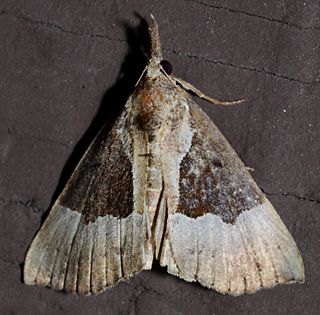
Hypena bijugalis, the dimorphic bomolocha, dimorphic hypena or toothed snout-moth, is a moth of the family Erebidae. The species was first described by Francis Walker in 1859. It is found in North America from Nova Scotia across southern Canada to Vancouver Island, south over the whole United States to Florida.

Asota plana is a moth in the family Erebidae first described by Francis Walker in 1854. It is found from the Oriental tropics east to New Guinea.
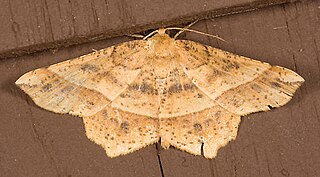
Euchlaena tigrinaria, the mottled euchlaena, is a moth of the family Geometridae. The species was first described by Achille Guenée in 1857. It is found from New Brunswick to Virginia, west to Texas, Utah and Oregon, north to British Columbia.

Hydrelia flammeolaria, the small yellow wave, is a moth of the family Geometridae. The species was first described by Johann Siegfried Hufnagel in 1767 It is found in most of the Palearctic realm, from western Europe to Japan.

Lycia ursaria, the stout spanworm moth or bear, is a moth of the family Geometridae. The species was first described by Francis Walker in 1860. It is found in southern Canada and the northern United States, south to New Jersey and Iowa.
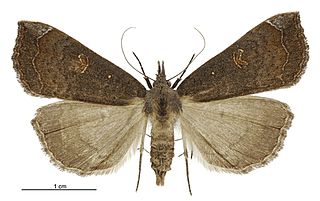
Rhapsa scotosialis, the slender owlet moth, is a moth of the family Noctuidae. This species is endemic to New Zealand and is found throughout the country. It is regarded as one of the most common forest moths found in New Zealand. The larval host species for R. scotosialis is Piper excelsum.
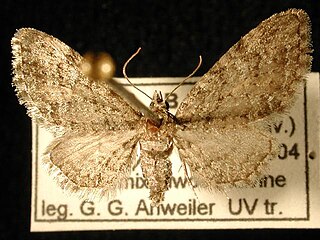
Eupithecia columbiata is a moth in the family Geometridae first described by Harrison Gray Dyar Jr. in 1904. It is found in North America from eastern Newfoundland and Labrador to Vancouver Island, south to North Carolina in the east and Colorado in the west. The habitat consists of deciduous and mixed-wood forests and forest edges, as well as shrubby areas.
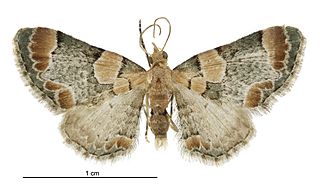
Chloroclystis lichenodes is a moth in the family Geometridae. It is endemic to New Zealand, where it has been recorded from the North Island, the South Island and Stewart Island. The habitat consists of forests.
Hydrelia percandidata is a moth in the family Geometridae. It is found in Transcaucasia and the Caucasus, as well as in Iran and Turkey.
Pandemis pyrusana, the apple pandemis or pandemis leafroller moth, is a species of moth of the family Tortricidae. The species was first described by William D. Kearfott in 1907. It is found in North America, where it has been recorded from Alberta to British Columbia, south through Idaho, Utah and Colorado and California. The habitat consists of forests with deciduous trees and shrubs.
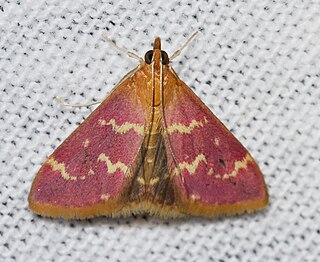
Pyrausta signatalis, the raspberry pyrausta moth, is a moth in the family Crambidae. It was described by Francis Walker in 1866.

Euthyatira pudens, the dogwood thyatirid moth or peach-blossom moth, is a moth of the family Drepanidae. The species was first described by Achille Guenée in 1852. It is found in North America, where it ranges across southern Canada, south to the Gulf of Mexico. The habitat consists of moist forests and riparian zones along creeks at low to middle elevations.
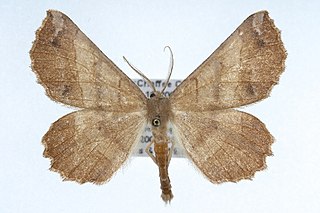
Euchlaena johnsonaria, or Johnson's euchlaena moth, is a moth of the family Geometridae. The species was first described by Asa Fitch in 1870. It is found in North America, where it has been recorded from southern coastal British Columbia east to Nova Scotia, south to New Jersey, Missouri and Oregon. The habitat consists of deciduous wooded areas.

Eudeilinia herminiata, the northern eudeilinia, is a moth in the family Drepanidae. It was described by Achille Guenée in 1857. It is found in North America, where it has been recorded from British Columbia to Newfoundland, south to Florida and west to Texas. The habitat consists of deciduous woods and wood edges.


















